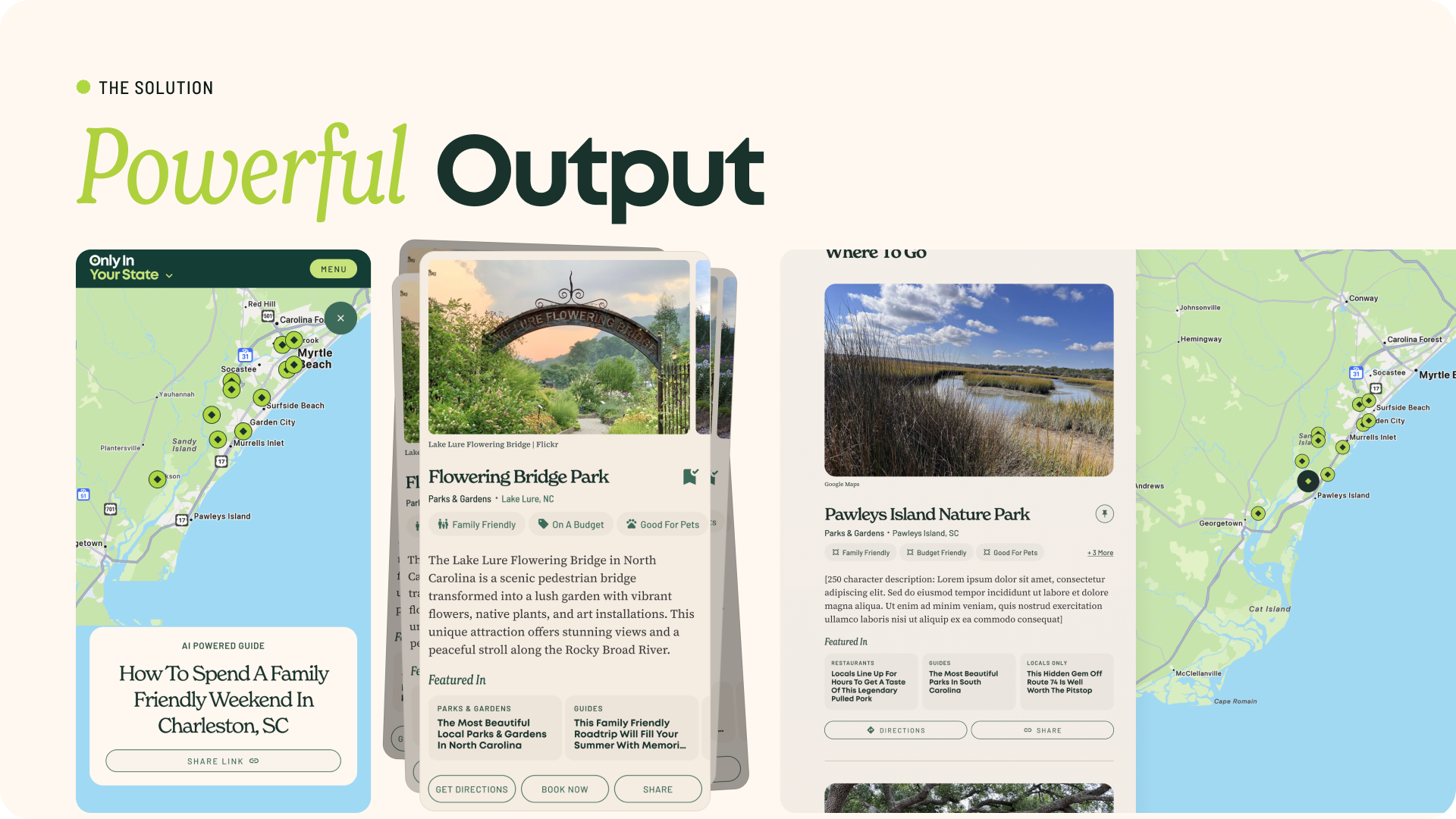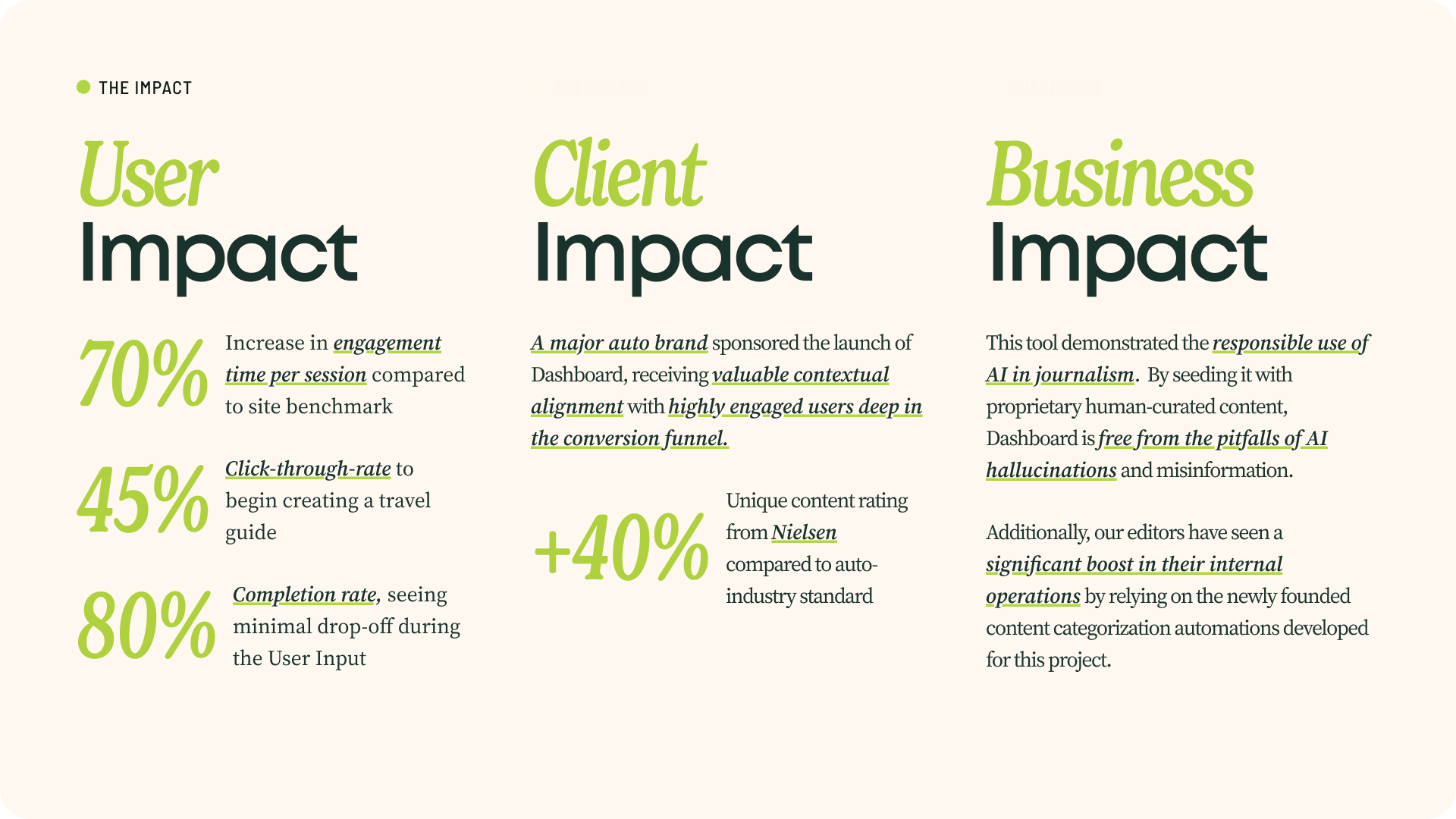Dash: Your AI Travel Companion
AI / Strategy & Direction / Creative Direction / UX / UIThis case study is a work in progress.
If you're seeing it, it's because I believe this project aligns closely with the challenges and opportunities of the role you're hiring for, and I couldn't wait to share a glimpse of how I think and lead.
I hope it piques your interest, and would be excited to discuss it more!
BackgroundOnly In Your State is the most inclusive local travel and discovery resource, with expertise spanning every city, state, and background across the country.
We fuel spontaneous travel with We fuel spontaneous travel with 50 state-specific channels, combining real traveler insights and editorial expertise with AI planning tools – all to make exploration more actionable. From hidden waterfalls, to scenic routes, to mom & pop eats, we help people chart their own course through the heart of America’s most beloved communities, uncovering backroads and unforgettable pit stops along the way.
At a glance:
3M Average Monthly Uniques
17.5M Followers across social
1.8M Email Subscribers
54.5M Total Social Engagements in 2024
40% Newsletter Open Rate.
THE PROBLEM
Travel Planning Is Broken.
Users are burdened with the overwhelming process of cross-referencing recommendations from scattered resources that favor mainstream out-of-reach tourist destinations over authentic local experiences that inspire us to explore our own backyards. After all, 59% of our audience prefer roadtrips above all other forms of travel.
We leveraged a vast archive of over 116,000 hyper-local articles to carve out a unique niche in the saturated travel content market. Our content focused on hidden gems and local favorites, differentiating us from the mainstream focus on trendy tourist destinations. However, our data was unstructured and inconsistent, making it difficult to utilize.
The primary issue was the lack of a cohesive tagging and hierarchical structure in our data. Each article was independently created without standardized metadata, making it impossible to efficiently identify themes, places mentioned, or relevant attributes. Manual organization would have been prohibitively time-consuming.
We partnered with our AI engineering team to develop a system that ingested all content and automatically applied a unified tagging structure. This system extracted themes, identified mentioned places, and cross-referenced locations with a maps API to enrich each entry with essential metadata like location, hours, and contact information.
This transformation turned our previously unusable dataset into a powerful, structured resource, enabling us to highlight unique travel experiences with rich, consistent information and greatly improving our content’s discoverability and usability.
With 59% of our 3 million monthly unique visitors preferring local road trips, and consistent feedback that users struggled to act on discovered locations, we identified a product opportunity. The goal was to make our extensive content more discoverable and actionable.
We experimented with user input methods, starting with a text/prompt-based interface similar to ChatGPT. However, we found that users unfamiliar with prompt crafting received poor results. We also ruled out chatbots due to user fatigue with the ubiquitous presence of these tools.
We designed a more guided, fill-in-the-blank style interface, asking users about their destination, trip length, time of year, travel companions, and interests. This streamlined approach allowed us to collect high-quality input, enabling our AI to deliver personalized, meaningful results seamlessly.
In response to fragmented user journeys across travel content platforms, we developed a dynamic content synthesis system that transformed user inputs into a cohesive, high-value experience. Rather than forcing users to sift through disparate articles, lists, and rankings, we designed a solution that aggregated all relevant data—spanning thousands of unique locations from our vast content library—into a single, tailored article.
Each page dynamically generated a comprehensive, map-enhanced itinerary showcasing every location, complete with photos, category tags (e.g., family-friendly, budget-conscious), and contextual details like city, state, operating hours, and seasonal availability. AI-driven summaries blended our editorial perspective with verified, objective data to deliver rich, reliable overviews for each place.
Interactive elements, including contextual calls-to-action (book now, get directions, purchase tickets, add to calendar), transformed passive browsing into an actionable user experience.
The results were compelling: 20% of users returned to these personalized itineraries, validating the strength and stickiness of the experience. This project demonstrated the power of strategic content unification, AI-enhanced storytelling, and actionable design in driving both engagement and conversion in a competitive travel landscape, additionally this tool demonstrated a responsible use of AI in journalism.
Negroni Design System →
Strategy / Research / Advocacy / Creative Direction / UX / UIThe proprietary Design System powering the front-end of every brand in Group Nine Media’s growing portfolio. This system maintains a consistent user experience across our products, makes new features available cross-brand with wild efficiency, and drastically reduces redundant coding, qa, and support all without sacrificing brand expression. Most importantly, it freed up my nimble team to focus on new priorities vs reinventing the wheel. Cheers 🥃.
NowThis News →
Strategy / Research / Direction / UX / UI“Homepage. Even the word sounds old. We bring the news to your social feed.” That simple brand-defining mission helped NowThis build a herculean one-of-a-kind brand that reaches over 80% of millennials in the US. It also meant their web experience needed to break the mold of traditional media just as much as their brand has.
Content Creation Tools →
Strategy / Research / Direction / UX / UIList-style recommendations are Group Nine’s most successful top-of-funnel content strategy. While they achieve their primary goal of generating significant traffic, they failed to achieve KPIs central to our success…All while requiring a significant amount of manual data collection & entry by our production teams, resulting in a lackluster experience for our readers.






